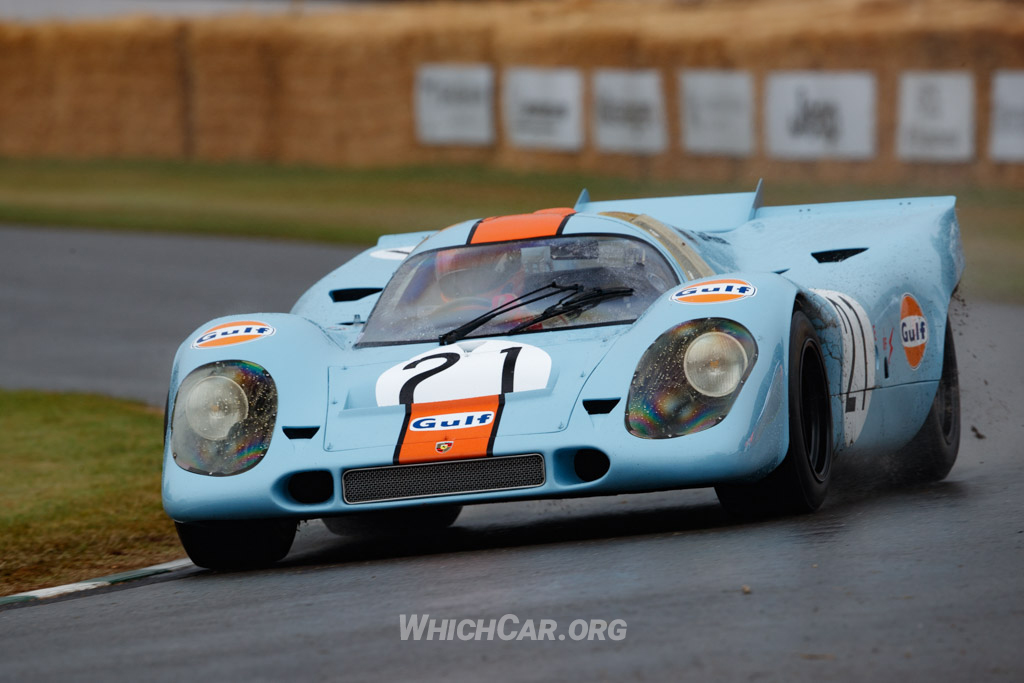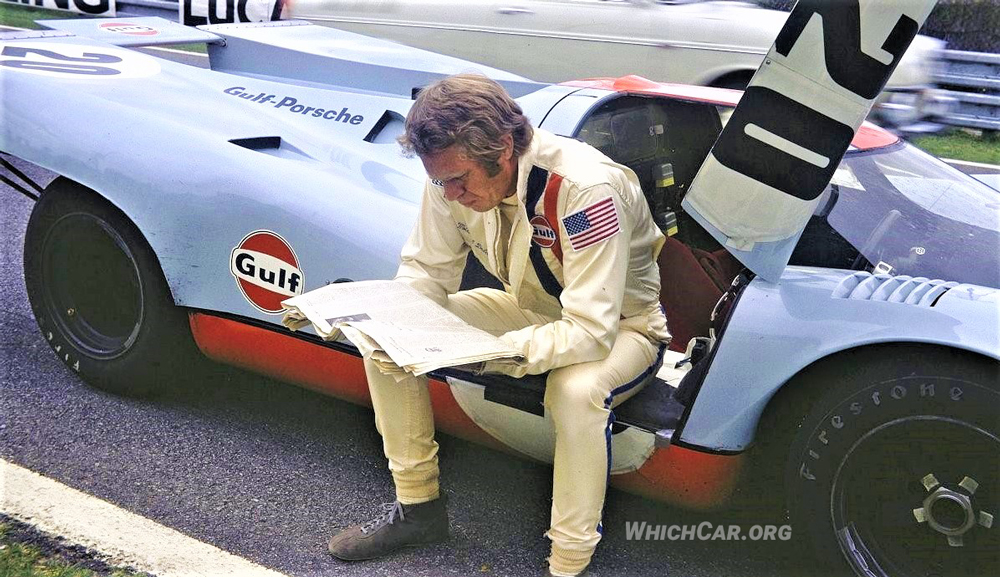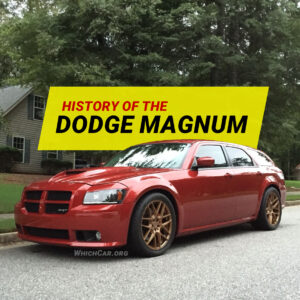Brief History of the Porsche 917
You could say a lot about this Porsche 917— it’s an engineering masterpiece, an unbeatable racer, and an unforgettable Hollywood star.
Updated: November 7, 2023 // History

Among all the iconic wedge-shaped race cars that graced the tracks of Le Mans during the 1970s, none have achieved the same level of notoriety as the legendary Porsche 917.
But if there’s one word that really captures it all it would be “masterpiece.”
What is the Porsche 917?
The Porsche 917 was custom-made to rule the racetrack, its eyes set on bagging top honors at Le Mans, a crown jewel in the FIA World Sportscar Championship. Most famously, it granted Porsche its first victories at Le Mans in both 1970 and 1971. Throughout its history, Porsche produced a few different versions of the 917. The most notable is the immensely powerful twin-turbocharged variant known as the Porsche 917/30.
Porsche 917 Fast Facts
| Key Features: | Powered by a flat-12 engine, which was created by combining two 6-cylinder 2.2-liter engines from the Porsche 911 Known for its impressive speed and powerful performance Starred in the famous Steve McQueen movie Le Mans |
| Specifications: | Engine: Air-cooled magnesium/aluminum alloy flat-12 engine Displacement: The 917 had a displacement of 4.5 L, while the 917/30 had a displacement of 5.4 L Horsepower: Ranged from around 520-600 for the 917, while the 917/30 had a range of 1100-1580 Torque: 810 ft-lbs @6400 rpm Top Speed: 240 mph Acceleration: 0-60 in about 2.1 seconds Body/Frame: body over tubular frame Drivetrain: RWD with LSD Transmission: Five-speed gearbox for the 917, Type 920 four-speed gearbox for the 917/30 Price: Valued between $14 and $18.5 million |
A Star is Born: The Birth of Porsche's 917
The swingin’ sixties was one of the best eras in racing history. Just think of the Ford GT40— need I say more? But with the FIA announcing new displacement and homologation rules in 1968, it spelled the end for the old guard and the start of a new era. Porsche saw this as the perfect opportunity to strike.
Ferdinand Piech, the big-boss of Porsche, had long dreamt of creating the perfect race car. With the new FIA rules in place, he gave the approval to start its development. Famed engineer Hans Menzer took the lead in developing the groundbreaking flat-12 engine for the Porsche 917. This Frankenstein’s monster was created by combining two 6-cylinder 2.2-liter engines from the Porsche 911. The first prototype of the Porsche 917 was completed in just 10 months. It was unveiled at the Geneva Motor Show in March 1969.
Related: The 10 Most Popular Dream Cars Today
A Wobbly Start for the 917
The Porsche 917 was not-so-smooth off the starting line, despite what you might think. Its initial design led to instability at high speed. Although its wedge shape helped it cut through the air like a hot knife through butter, it also resulted in aerodynamic lift, leading to accidents and criticism from its drivers.
Porsche quickly addressed these concerns by collaborating with John Wyer and his JWA Gulf Racing Team. With a few modifications, they fixed the instability of the 917 and dramatically improved its handling. The changes included a new metal tail, which became one of the most noticeable parts of the Porsche 917K.
Want More Car History? The GMC Typhoon: The Performance SUV of The 90’s
The Porsche 917 Leaves its Mark on Le Mans

With the new-and-improved Porsche 917, it was finally time for Porsche to make their mark on Le Mans. Three Porsche 917s took to the track in 1970 in the 917L “long-tail” variant. Despite challenging weather conditions, Porsche’s 917L secured the victory at the 24 Hours of Le Mans in 1970.
Porsche returned the following year, hoping to repeat their successful formula, this time with an upgraded 917K. The Porsche 917K delivered an even more impressive performance at the 1971 Le Mans. The car covered over 400 more miles in the race than the previous year’s winning 917. It was another triumph for Porsche.
Love Porsche? 2025 C8 Corvette ZR1 Testing Against a Porsche 911 GT2 RS
The 917 Takes on the Silver Screen
The thrilling and captivating experience of the 1970 24 Hours of Le Mans couldn’t escape Hollywood’s attention. It inspired the creation of Le Mans, a 1971 film starring Steve McQueen. Alongside McQueen himself, the spotlight shone on none other than the Porsche 917. Steve McQueen owned one of the actual three 917s used in the 1970 Le Mans race, and it featured prominently in the movie in its iconic blue and orange Gulf livery.
Known for his impressive stunt driving performances in movies like Bullitt and The Great Escape, as well as his remarkable collection of sports cars, it was only natural that Steve McQueen would be involved in the making of Le Mans. Adding another layer of authenticity to the story, the film showcased actual racing footage from the 1970 Le Mans race.
Le Mans captured the intensity and passion of endurance racing, captivating a generation of fans who adorned their bedroom walls with posters of the iconic Porsche 917 well into the ‘70s.
What Happened to Steve McQueen’s Porsche 917?

Following its appearance on screen in 1971, McQueen’s 917 underwent a series of transformations. It was sent back to the factory, where it was rebuilt according to Porsche 917 Spyder specifications. It continued to race until 1973. Since then it has changed hands several times and undergone extensive restoration work.
This very Porsche 917, associated with Steve McQueen himself, went up for auction again in 2021. It is estimated to bring in between $16 and $18.5 million. For context, another Porsche 917 that competed at the Le Mans race in 1970 was sold for $14,080,000 in 2017, setting a record for any Porsche car.
See More Speed: Jeep Grand Cherokee Trackhawk: Hellcat History
Other Members of the Porsche 917 Family
Porsche produced a few different versions of the 917, each tailored specifically for different racing conditions. One notable variant is the Porsche 917LH, which featured an elongated tail designed for better aerodynamics. Another notable car is the “Pink Ping,” also known as the Porsche 917/20, which stands out for its bulkier proportions and unique livery featuring cuts of meat.
The Porsche 917/30 Dominates the Can-Am Series
The most powerful of the 917 variants, the Porsche 917/30 was specifically developed for the Can-Am series. Its engine bore was increased, resulting in a displacement of 5.4 liters. With the help of two turbochargers, this beastly machine had an output ranging from 1100 to 1580 hp, depending on the tuning. It consistently dominated the Can-Am series to such an extent that it reportedly contributed to a decline in the event’s popularity in the US.
Porsche 917 Questions
In 1970 and 1971, the Porsche 917 helped Porsche racing team win its first races at the 24 Hours of Le Mans. It also did well in races like the Can-Am Series and others.
Production of the Porsche 917 began in 1969 and was completed in just 10 months. Porsche continued production of several 917 variants until 1973.
25 units of the Porsche 917 were initially produced to meet homologation requirements. A total of 65 units were made until 1973.
The Porsche 917LH variant clocked in at a whopping 240 mph during a test-run.
One Porsche 917 was purchased for a record-breaking $14,080,000 in 2017.
Disclaimer: The writers of this article may have used artificial intelligence to help them with some of the material. It should not be a replacement for professional help.
Sources:
- “1970 Porsche 917 K | Monterey 2021.” RM Sotheby’s, rmsothebys.com/en/auctions/mo21/monterey/lots/r0008-1970-porsche-917-k/1102159. Accessed 5 Sept. 2023.
- Block, Fang. “A 1970 Porsche 917K Featured in “Le Mans” Movie Expected to Get More than $16 Million.” http://www.barrons.com, 21 May 2021, http://www.barrons.com/articles/a-1970-porsche-917k-featured-in-le-mans-movie-expected-to-get-more-than-us-16-million-01621633008. Accessed 5 Sept. 2023.
- Dellis, Nicolaos. “Porsche 917 Technical Details.” Stuttcars, 26 July 2021, http://www.stuttcars.com/porsche-917-technical-details/. Accessed 5 Sept. 2023.
- “Porsche 917 Archives - International Motor Racing Research Center.” http://Www.racingarchives.org, http://www.racingarchives.org/tag/porsche-917/. Accessed 5 Sept. 2023.
- “Porsche 917 Research Hub.” Stuttcars, http://www.stuttcars.com/porsche-model-research/porsche-917-research/. Accessed 5 Sept. 2023.
- “The Porsche 917 - the Greatest Racing Car of All Time?” Porsche, http://www.porsche.com/stories/innovation/why-the-porsche-917-is-a-gamechanger. Accessed 5 Sept. 2023.







